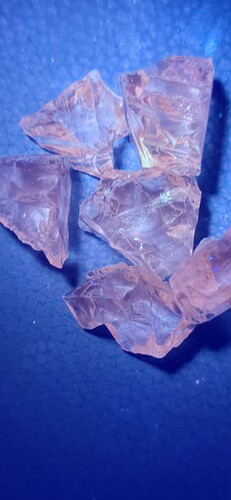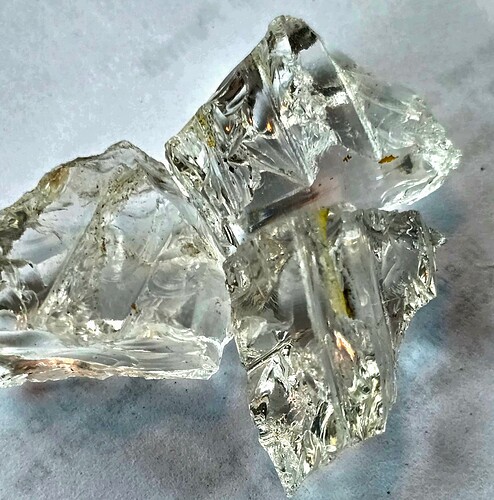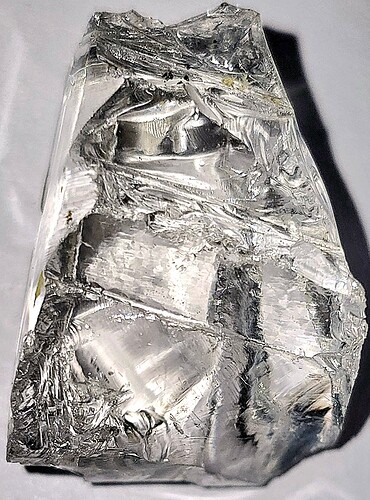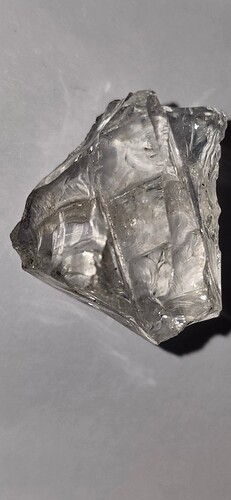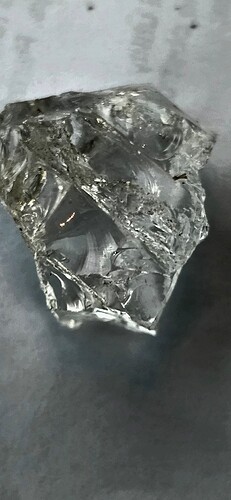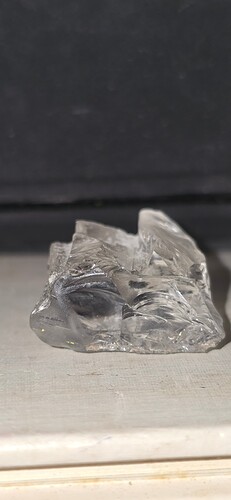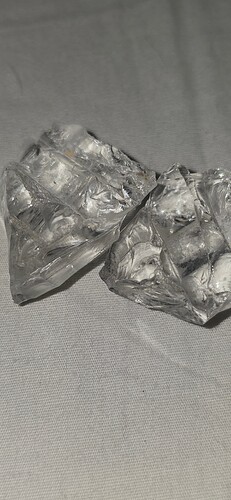I found these in texas and they are crystal clear with absolutely no bubbles, inclusions or anything in them just like glass. It doesnt chip like glass it grinds like quartz and glows pink under UV light. U can see a slight surface blue hue in the reflection on surface in the light but other then that its clear qs clear can be. Never seen any this clear or with striations on them. What your opinion and what would u value them at. Thanks
Manganese Dioxide or Selenium can make certain types of borosilicate glass glow pink under a UV light.
So a few musings. Where did you find these and is there a possibility that this was discarded or volcanic/natural origin glass? Troy, can you say what the SG of pink-glowing borosilicate glass is likely to be? These look like they might be large enough pieces that one could easily get an SG with a cheap gram scale. I had been tying specimens with string for this, but recently started using CA glue to bond the string to the specimen. Look at SG of quartz vs glass. Try a hardness test, altho borosilicate glass can be up to 7.5 in hardness. Complete absence of bubbles argues against glass. I’d use a microscope to examine in air and then in immersion fluid. There ought to be some inclusions somewhere. I see a conchoidal fracture on one piece at least, but the pieces seem a little smoothed, which suggests water worn, but they aren’t at all rounded, which does suggest glass to me…I would look to see if quartz from the area you found these in ever has a pink UV response. Myself, I’d grind a flat and take an RI and look at birefringence and dispersion estimate, but you may not be able to do that unless you find a local lapidary to help. I’d also hold it up to the light and turn it all sorts of ways to see if I could find the overlapping rainbows you easily see in quartz faceted stones (visual optics of Hodgkinson and Hanneman). -royjohn
Borosilicate glass:
-
SpG: 2.23; This will vary based on additives and the formula for the type of borosilicate glass (Pyrex, Schott BK-7, etc.).
-
RI: 1.474; becomes nearly transparent when immersed in mineral oil.
-
Schott BK-7 has a RI = 1.516
Apologize, I posted the original comment to Michael (@MichaelS21250) without any sustaining data and I completely mis-spoke on the type of glass that Manganese Dioxide / Selenium is added to.
Manganese Dioxide and Selenium can be used to visually remove the green tint (hue) in soda-lime glass . Both de-colorants will cause the host glass to fluoresce pink with UV specific light.
Glass Coloring Manganese Dioxide was common in the late 19th / early 20th century.
The lack of visual bubble inclusions (eye-clean) is a commonly sought after feature for borosilicate glasses. Admittedly, these are called “crown glass” as they are specialized and not as common as the soda-lime variety. But the specimen shapes posted in the images brough back a wayward memory involving optical glass fabrication (lenses and mirrors) using Schott BK-7. The raw material was provided in similar chunky shapes.
Cheers!
Looks like the topaz we find in my part of Texas.
